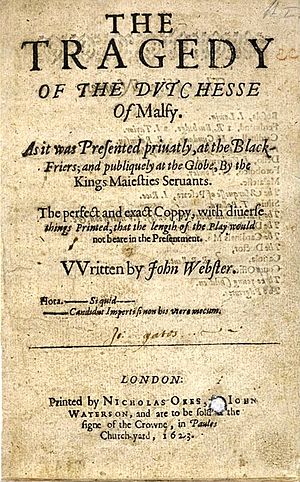John Webster facts for kids
Quick facts for kids
John Webster
|
|
|---|---|
| Born | c. 1578 London, England |
| Died | c. 1626 (age 53 or 54) London, England |
| Spouse | Sara Peniall |
John Webster (around 1578 – around 1632) was an English dramatist who wrote plays during the Jacobean period. He is most famous for his tragedies The White Devil and The Duchess of Malfi. These plays are often seen as amazing works from the early 1600s English theater. His life and career happened at the same time as Shakespeare's.
Contents
About John Webster
We don't know much about John Webster's life, and his exact birth and death dates are a bit of a mystery. His father, also named John Webster, made carriages. He married Elizabeth Coates in 1577. It's likely that John Webster was born soon after, in or near London.
His family lived in a part of London called St Sepulchre's parish. Both his father and uncle were part of the Merchant Taylors' Company, a group of skilled workers. John Webster went to Merchant Taylors' School in London.
In 1605, Webster married Sara Peniall. She was 17 years old. They had their first child, John Webster III, in 1606. Records show they likely had other children too.
Most of what we know about Webster comes from his work in the theater. He was still writing plays in the mid-1620s. However, another writer, Thomas Heywood, wrote about him in 1634 as if he had already passed away. This suggests Webster died sometime before 1634.
There are no known pictures of John Webster.
Working with Other Playwrights
By 1602, Webster started working with other playwrights. They wrote history plays together, but most of these were never printed. One play was a tragedy called Caesar's Fall. He wrote this with Michael Drayton, Thomas Dekker, Thomas Middleton, and Anthony Munday.
He also worked with Dekker on Christmas Comes but Once a Year (1602). They wrote Sir Thomas Wyatt together, which was printed in 1607. Webster also helped adapt John Marston's play The Malcontent for the King's Men acting company.
His Most Famous Tragedies
Even though Webster could write comedies, he is best known for two dark and serious tragedies. These plays were based on true stories from Italy.
His play The White Devil tells the story of Vittoria Accoramboni, an Italian woman. When it was first performed in 1612, it was not very popular. People thought it was too unusual and complicated for the audience at the time.
His other famous play, The Duchess of Malfi, was first performed around 1614. It was much more successful. He also wrote a play called Guise, based on French history, but the text of this play has been lost.
Later Plays
Webster wrote one more play by himself called The Devil's Law Case (around 1617–1619). This was a tragicomedy, which means it had elements of both tragedy and comedy.
His later plays were often comedies that he wrote with other people. For example, in 1624, he helped write Keep the Widow Waking with John Ford, Rowley, and Dekker. This play is now lost, but we know its story from a court case. He also likely helped write The Fair Maid of the Inn with John Fletcher, Ford, and Phillip Massinger. The exact date of his play Appius and Virginia, which he probably wrote with Thomas Heywood, is not known.
Why Webster's Plays Are Important
Webster's plays are detailed and smart. They can be challenging to understand, but they are very rewarding to watch or read. They are still performed often today.
Webster is known for showing a very dark view of human nature in his plays. The poet T. S. Eliot once said that Webster always saw "the skull beneath the skin." This means Webster looked past appearances to the harsh realities of life and death.
In The Duchess of Malfi, the main character, the Duchess, is shown as a good person. She is much better than her evil brothers. She faces death with great courage, like a Stoic philosopher. Her death scene is often compared to a martyr, someone who suffers for their beliefs. Webster's choice to make a strong, good woman his main character was unusual for his time. He changed some of the real historical events to make her more virtuous.
For a long time, in the 1700s and 1800s, people didn't think much of Webster's plays. But in the 1900s, many critics and theatergoers started to see The White Devil and The Duchess of Malfi as brilliant plays with beautiful poetry. One reason for this change might be that the terrible events of the early 20th century, like wars, made people understand characters who faced desperate situations. Webster's plays, with their sometimes sad or tough outlook, seemed to connect with modern feelings.
Images for kids
See also
 In Spanish: John Webster para niños
In Spanish: John Webster para niños



